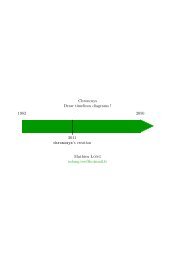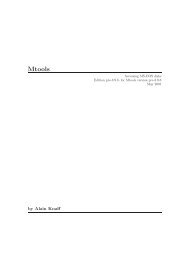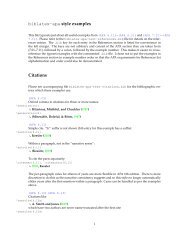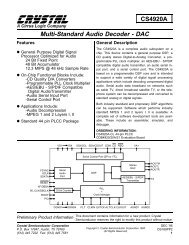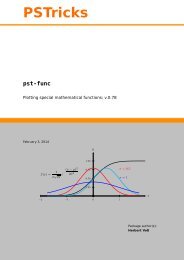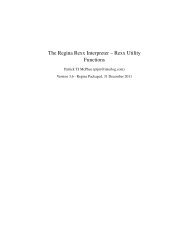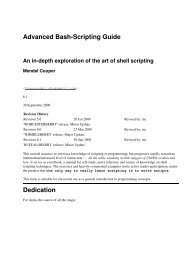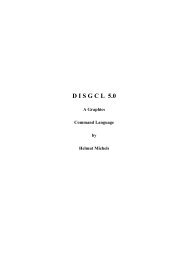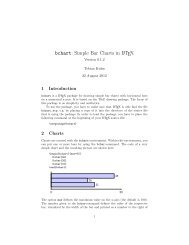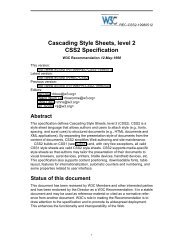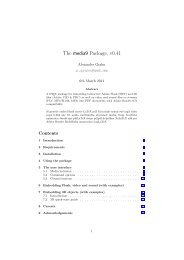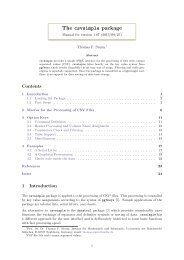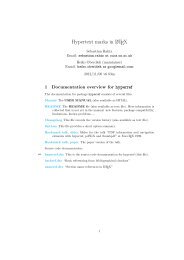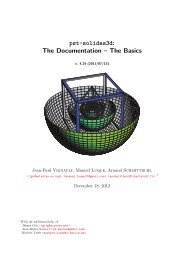DISLIN 8.4
DISLIN 8.4
DISLIN 8.4
You also want an ePaper? Increase the reach of your titles
YUMPU automatically turns print PDFs into web optimized ePapers that Google loves.
c○ Helmut Michels, Max-Planck-Institut f”ur Sonnensystemforschung, Katlenburg-Lindau 1997 - 2005All rights reserved.
Chapter 1Overview1.1 IntroductionThis manual describes a data plotting extension for the interpreted, object-oriented programming languagePython. The plotting extension is based on the data plotting library <strong>DISLIN</strong> that is available forseveral C, Fortran 77 and Fortran 90 compilers.<strong>DISLIN</strong> is a high-level plotting library that contains subroutines and functions for displaying data graphicalllyas curves, bar graphs, pie charts, 3-D colour plots, surfaces, contours and maps. The librarycontains about 400 plotting and parameter setting routines which are now available from Python. Somequickplots are also added to the <strong>DISLIN</strong> module for displaying curves, surfaces and contours with onecommand.1.2 <strong>DISLIN</strong> FeaturesThe following features are supported by <strong>DISLIN</strong>:- Several output formats can be selected such as X11, PostScript, PDF, CGM, Prescribe, TIFF andHPGL.- 9 software fonts are available where each font provides 6 alphabets and special european characters.Hardware fonts for PostScript printers and X11 and Windows displays can also be used.- Plotting of two- and three-dimensional axis systems. Axes can be linearly or logarithmically scaledand labeled with linear, logarithmic, date, time, map and user-defined formats.- Plotting of curves. Several curves can appear in one axis system and can be differentiated bycolour, line style and pattern. Multiple axis systems can be displayed on one page.- Plotting of legends.- Elementary plot routines for lines, vectors and outlined or filled regions such as rectangles, circles,arcs, ellipses and polygons.- Shielded regions can be defined.- Business graphics.- 3-D colour graphics.- 3-D graphics.- Elementary image routines.1
Helmut MichelsMax-Planck-Institut fuer SonnensystemforschungD-37191 Katlenburg-Lindau, Max-Planck-Str. 2, GermanyE-Mail: michels@mps.mpg.deTel.: +49 5556 979 334Fax: +49 5556 979 2404
Chapter 2QuickplotsThis chapter presents quickplots that are collections of <strong>DISLIN</strong> routines to display data with one command.The following rules are applied to quickplots:- Quickplots call DISINI automatically if it is not called before. METAFL (’XWIN’) will be usedin quickplots if METAFL is not used before.- On window terminals, there are no calls to ENDGRF and DISFIN in quickplots, they let <strong>DISLIN</strong>in level 2 or 3. If the variable ERASE is set to 0, following quickplots will overwrite the graphicswindow without erasing the window.2.1 The PLOT FunctionThe function ’plot’ makes a quickplot of two floatingpoint arrays.The call is:xray, yrayplot (xray, yray)are floatingpoint arrays.Example: from math import *from dislin import *x = range (100)y = range (100)for i in range (0, 100) :v = y[i] / 5.y[i] = sin (v)plot (x, y)2.2 The SCATTR FunctionThe function ’scattr’ makes a quickplot of two floatingpoint arrays where the points are marked withsymbols.The call is:xray, yrayscattr (xray, yray)are floatingpoint arrays.5
xrayyrayzlvrayis a floatingpoint array with the dimension nx. It will be used to position the rows ofzmat.is a floatingpoint array with the dimension ny. It will be used to position the columnsof zmat.is a floatingpoint array containing the levels. If zlvray is missing, 10 levels betweenthe minimum and maximum of zmat will be generated.2.8 The CONSHADE FunctionThe function ’conshade’ makes a shaded contour plot of a matrix.The call is:zmatxrayyrayzlvrayconshade (zmat, xray, yray [,zlvray])is a two-dimensional floatingpoint array with nx rows and ny columns.is a floatingpoint array with the dimension nx. It will be used to position the rows ofzmat.is a floatingpoint array with the dimension ny. It will be used to position the columnsof zmat.is a floatingpoint array containing the levels. If zlvray is missing, 10 levels betweenthe minimum and maximum of zmat will be generated.2.9 Scaling of QuickplotsNormally, quickplots are scaled automatically in the range of the data. This behaviour can be changed ifcertain variables are defined.The variables for the X-axis are:a) If the variables XMIN and XMAX are defined, the X-axis will be scaled automaticallyin the range XMIN, XMAX.b) If the variables XMIN, XMAX, XOR and XSTEP are defined, the scaling and labelingof the X-axis is completly defined by the user.c) If the variable XAUTO is defined and set to 1, the variables XMIN, XMAX, XORand XSTEP will be ignored and scaling will be done automatically in the range ofthe data.Analog:Y-axis, Z-axis.Notes: - For logarithmic scaling, the parameters must be exponents of base 10.- Scaling variables can be defined with the function ’setvar (cname, value)’ wherecname is a string containing the name of the variable and value a numeric value.Example: from Numeric import *from dislin import *setvar (’YMIN’, -0.8)setvar (’YMAX’, 0.8)x = arange (100, typecode = Float32)plot (x, sin(x/5))7
2.10 Quickplot VariablesThere is a set of variables that can modify the appearance of quickplots. They can be defined with thefunction setvar that has the syntax setvar (cname, value) where cname is a string containing the name ofthe variable and value is a numeric value or a string. The following table shows all quickplot variables.The corresponding <strong>DISLIN</strong> routines are given in parenthesis.XYZT1T2T3T4XTICYTICZTICXDIGYDIGZDIGXSCLYSCLZSCLXLABYLABZLABHHNAMEHTITLEXPOSYPOSXLENYLENZLENPOLCRVINCMRKMARKERHSYMBLdefines the X-axis title (NAME).defines the Y-axis title (NAME).defines the Z-axis title (NAME).defines line 1 of the axis system title (TITLIN).defines line 2 of the axis system title (TITLIN).defines line 3 of the axis system title (TITLIN).defines line 4 of the axis system title (TITLIN).sets the number of ticks for the X-axis (TICKS).sets the number of ticks for the Y-axis (TICKS).sets the number of ticks for the Z-axis (TICKS).sets the number of digits for the X-axis (DIGITS).sets the number of digits for the Y-axis (DIGITS).sets the number of digits for the Z-axis (DIGITS).defines the scaling of the X-axis (SCALE).defines the scaling of the Y-axis (SCALE).defines the scaling of the Z-axis (SCALE).defines the labels of the X-axis (LABELS).defines the labels of the Y-axis (LABELS).defines the labels of the Z-axis (LABELS).defines the character size (HEIGHT).defines the size of axis titles (HNAME).defines the size of the axis sytem title (HTITLE).defines the X-position of the axis system (AXSPOS).defines the Y-position of the axis system (AXSPOS).defines the size of an axis system in X-direction (AXSLEN).defines the size of an axis system in Y-direction (AXSLEN).defines the size of an axis system in Z-direction (AX3LEN).defines an interpolation method used by CURVE (POLCRV).defines line or symbol mode for CURVE (INCMRK).selctes a symbol for CURVE (MARKER).defines the size of symbols (HSYMBL).8
XRESYRESX3VIEWY3VIEWZ3VIEWX3LENY3LENZ3LENVTITLECONSHDNote:sets the width of points plotted by PLOT3 (SETRES).sets the height of points plotted by PLOT3 (SETRES).sets the X-position of the viewpoint in absolut 3-D coordinates (VIEW3D).sets the Y-position of the viewpoint in absolut 3-D coordinates (VIEW3D).sets the Z-position of the viewpoint in absolut 3-D coordinates (VIEW3D).defines the X-axis length of the 3-D box (AXIS3D).defines the Y-axis length of the 3-D box (AXIS3D).defines the Z-axis length of the 3-D box (AXIS3D).defines vertical shifting for the axis system title (VKYTIT).selects an algorithm used for contour filling (SHDMOD).The variables can also be used, to initalize plotting parameters in DISINI.Example: from Numeric import *from dislin import *setvar (’X’, ’X-axis’)setvar (’Y’, ’Y-axis’)xray = arange (10, typecode = Float32)plot (xray, xray)9
Appendix AShort Description of <strong>DISLIN</strong> RoutinesThis appendix presents a short description of all <strong>DISLIN</strong> routines that can be called from Python. Acomplete description of the routines can be found in the <strong>DISLIN</strong> manual or via the online help of <strong>DISLIN</strong>.For parameters, the following conventions are used:- integer variables begin with the character N or I;- strings begin with the character C;- other variables are floatingpoint numbers;- one-dimensional arrays end with the keyword ’ray’, two-dimensional arrays with the keyword’mat’.A.1 Initialization and Introductory RoutinesRoutinecgmbgd (xr, xg, xb)cgmpic (cstr)disini ()erase ()errdev (cdev)errfil (cfil)errmod (ckey, copt)filbox (nx, ny, nw, nh)gifmod (cmod, ckey)hworig (nx, ny)hwpage (nw, nw)imgfmt (copt)incfil (cfil)metafl (cfmt)newpag ()origin (nx, ny)page (nw, nh)pagera ()pagfll (iclr)paghdr (c1, c2, iopt, idir)pagmod (copt)pagorg (copt)Meaningdefines the background colour for CGM files.sets the picture ID for CGM files.initializes <strong>DISLIN</strong>.clears the screen.defines the error device.sets the name of the error file.modifies the printing of error messages.defines the position and size of included metafiles.enables transparency for GIF files.defines the origin of the PostScript hardware page.defines the size of the PostScript hardware page.defines the format of image files.includes metafiles into a graphics.defines the plotfile format.creates a new page.defines the origin.sets the page size.plots a page border.fills the page with a colour.plots a page header.selects a page rotation.defines the origin of the page.11
Routinen = pdfbuf (cbuf, nmax)pdfmod (cmod, ckey)pdfmrk (cstr, copt)pngmod (cmod, ckey)sclfac (x)sclmod (copt)scrmod (copt)setfil (cfil)setpag (copt)setxid (id, copt)symfil (cdev, cstat)tifmod (n, cval, copt)unit (nu)units (copt)wmfmod (cmod, ckey)Meaningcopies a PDF file to a buffer. The memoryfor the buffer is allocated by pdfbuf.defines PDF options.defines kookmarks for PDF files.enables transparency for PNG files.defines a scaling factor for the entire plot.defines a scaling mode.swaps back- and foreground colours.sets the plotfile name.selects a predefined page format.defines an external X Window or pixmap.sends a plotfile to a device.defines the physical resolution of TIFF files.defines the logical unit for messages.defines the plot units.modifies the format of WMF files.Figure A.1: Initialization and Introductory RoutinesA.2 Termination and Parameter ResettingRoutineMeaningdisfin ()terminates <strong>DISLIN</strong>.endgrf () terminates an axis system and sets the level to 1.reset (copt)resets parameters to default values.Figure A.2: Termination and Parameter ResettingA.3 Plotting Text and NumbersRoutineangle (n)chaang (x)chaspc (x)chawth (x)fixspc (x)frmess (nfrm)height (n)messag (cstr, nx, ny)mixalf ()newmix ()Meaningdefines the character angle.defines an inclination angle for characters.affects character spacing.affects the width of characters.sets a constant character width.defines the thickness of text frames.defines the character height.plots text.enables control signs in character strings forplotting indices and exponents.defines an alternate set of control characters forplotting indices and exponents.12
Routinen = nlmess (cstr)number (x, ndig, nx, ny)numfmt (copt)numode (c1, c2, c3, c4)rlmess (cstr, x, y)rlnumb (x, ndig, xp, yp)setbas (xfac)setexp (xfac)setmix (char, cmix)texmod (cmode)texopt (copt, ctype)txtjus (copt)Meaningreturns the length of character strings in plotcoordinates.plots floating-point numbers.determines the format of numbers.modifies the appearance of numbers.plots text.plots numbers.determines the position of indices and exponents.sets the height of indices and exponents.defines global control signs for plotting indicesand exponents.enables TeX mode for plotting mathematical formulas.defines TeX options.defines the alignment of text and numbers.Figure A.3: Plotting Text and NumbersA.4 ColoursRoutinecolor (color)xr,xg,xb = hsvrgb (xh, xs, xv)n = indrgb (xr, xg, xb)n = intrgb (xr, xg, xb)myvlt (rray, gray, bray, n)xh,xs,xv = rgbhsv (xr, xg, xb)setclr (nclr)setind (i, xr, xg, xb)setrgb (xr, xg, xb)setvlt (cvlt)vltfil (cfil, cmod)Meaningdefines colours.converts HSV to RGB coordinates.calculates a colour index.calculates an explicit colour value.changes the current colour table.converts RGB to HSV coordinates.defines colours.changes the current colour table.defines colours.selects a colour table.store or loads a colour table.Figure A.4: Colours13
A.7 Axis SystemsRoutineMeaningaddlab (cstr, v, itic, cax) plots additional single labels.ax2grf ()suppresses the plotting of the upper X- and theleft Y-axis.ax3len (nxl, nyl, nzl)defines axis lengths for a coloured 3-D axis system.axsbgd (iclr)defines the background colour.axslen (nxl, nyl)defines axis lengths for a 2-D axis system.axsorg (nx, ny)determines the position of a crossed axis system.axspos (nxp, nyp)determines the position of axis systems.axstyp (ctype)select rectangular or crossed axis systems.axgit () plots the lines X = 0 and Y = 0.box2d ()plots a border around an axis system.center ()centres axis systems.cross ()plots the lines X = 0 and Y = 0 and marks themwith ticks.endgrf ()terminates an axis system.frame (nfrm)defines the frame thickness of axis systems.frmclr (nclr)defines the colour of frames.grace (ngrace)affects the clipping margin of axis systems.graf (xa, xe, xor, xstp,plots a two-dimensional axis system.ya, ye, yor, ystp)graf3 (xa, xe, xor, xstp, plots an axis system for colour graphics.ya, ye, yor, ystp,za, ze, zor, zstp)grdpol (nx, ny)plots a polar grid.grid (nx, ny)overlays a grid on an axis system.noclip ()suppresses clipping of user coordinates.nograf ()suppresses the plotting of an axis system.polar (xe, xor, xstp, yor, ystp) plots a polar axis system.polmod (cpos, cdir)modifies the appearance of polar labels.setgrf (c1, c2, c3, c4)suppresses parts of an axis system.setscl (xray, n, cax)sets automatic scaling.title ()plots a title over an axis system.xaxgit () plots the line Y = 0.xcross ()plots the line Y = 0 and marks it with ticks.yaxgit () plots the line X = 0.ycross ()plots the line X = 0 and marks it with ticks.Figure A.7: Axis Systems15
A.8 Secondary AxesRoutinexaxis (xa, xe, xor, xstp,nl, cstr, it, nx, ny)xaxlg (xa, xe, xor, xstp,nl, cstr, it, nx, ny)yaxis (ya, ye, yor, ystp,nl, cstr, it, nx, ny)yaxlg (ya, ye, yor, ystp,nl, cstr, it, nx, ny)zaxis (za, ze, zor, zstp,nl, cstr, it, id, nx, ny)zaxlg (za, ze, zor, zstp,nl, cstr, it, id, nx, ny)Meaningplots a linear X-axis.plots a logarithmic X-axis.plots a linear Y-axis.plots a logarithmic Y-axis.plots a linearly scaled colour bar.plots a logarithmically scaled colour bar.Figure A.8: Secondary AxesA.9 Modification of AxesRoutineaxclrs (nclr, copt, cax)axends (copt, cax)axsscl (copt, cax)hname (nh)intax ()labdig (ndig, cax)labdis (ndis, cax)labels (copt, cax)labjus (copt, cax)labmod (ckey, cval, cax)labpos (copt, cax)labtyp (copt, cax)logtic (copt)mylab (cstr, itic, cax)namdis (ndis, cax)name (cstr, cax)namjus (copt, cax)noline (cax)rgtlab ()rvynam ()ticks (ntics, cax)ticlen (nmaj, nmin)ticmod (copt, cax)Meaningdefines colours for axis elements.suppresses certain labels.defines the axis scaling.defines the character height of axis names.defines integer numbering for all axes.sets the number of decimal places for labels.sets the distance between labels and ticks.selects labels.defines the alignment of axis labels.modifies date labels.determines the position of labels.defines vertical or horizontal labels.modifies the appearance of logarithmic ticks.sets user-defined labels.sets the distance between axis names and labels.defines axis titles.defines the alignment of axis titles.suppresses the plotting of axis lines.right-justifies labels.defines an angle for Y-axis names.sets the number of ticks.sets the length of ticks.modifies the plotting of ticks at calendar axes.16
Routineticpos (copt, cax)timopt ()Meaningdetermines the position of ticks.modifies time labels.Figure A.9: Modification of AxesA.10 Axis System TitlesRoutinehtitle (nh)lfttit ()linesp (xfac)titjus (copt)title ()titlin (cstr, ilin)titpos (copt)vkytit (nshift)Meaningdefines the character height of titles.left-justifies title lines.defines line spacing.defines the alignment of titles.plots axis system titles.defines text lines for titles.defines the position of titles.shifts titles in the vertical direction.Figure A.10: System TitlesA.11 Plotting Data PointsRoutinebars (xray, y1ray, y2ray, n)bars3d (xray, yray, z1ray, z2ray,xwray, ywray, icray, n)chnatt ()chncrv (copt)color (color)crvmat (zmat, n, m,ixpts, iypts)curve (xray, yray, n)curve3 (xray, yray, zray, n)curvx3 (xray, y, zray, n)curvy3 (x, yray, zray, n)errbar (xray, yray,e1ray, e2ray, n)field (x1ray, y1ray,x2ray, y2ray, n, ivec)gapcrv (xgap)inccrv (ncrv)incmrk (nmrk)marker (nsym)Meaningplots a bar graph.plots 3-D bars.changes curve attributes.defines attributes changed automatically by CURVE.defines the colour used for text and lines.plots a coloured surface.plots curves.plots coloured rectangles.plots rows of coloured rectangles.plots columns of coloured rectangles.plots error bars.plots a vector field.defines gaps plotted by CURVE.defines the number of curves plotted with equalattributes.selects symbols or lines for CURVE.sets the symbols plotted by CURVE.17
Routinenochek ()piegrf (cbuf, nlin, xray, n)polcrv (copt)resatt ()setres (nx, ny)shdcrv (x1ray, y1ray, n1,x2ray, y2ray, n2)splmod (ngrad, npts)thkcrv (nthk)Meaningsuppresses listing of out of range data points.plots a pie chart.defines the interpolation method used by CURVE.resets curve attributes.sets the size of coloured rectangles.plots shaded areas between curves.modifies spline interpolation.defines the thickness of curves.Figure A.11: Plotting Data PointsA.12 LegendsRoutineframe (nfrm)legend (cbuf, ncor)legini (cbuf, nlin, nmaxln)leglin (cbuf, cstr, ilin)iclr, ipat, ilin)legopt (xf1, xf2, xf3)legpat (ityp, ithk, isym,legpos (nxp, nyp)legtit (ctitle)linesp (xfac)mixleg ()nxl = nxlegn (cbuf)nyl = nylegn (cbuf)Meaningsets the frame thickness of legends.plots legends.initializes legends. cbuf is a dummy parameterfor Python. The text of legend lines is storedin an internal buffer.defines text for legend lines.modifies the appearance of legends.stores curve attributes.determines the position of legends.defines the legend title.affects line spacing.enables multiple text lines in legends.returns the width of legends in plot coordinates.returns the height of legends in plot coordinates.Figure A.12: Legends18
A.13 Line Styles and Shading PatternsRoutinechndot ()chndsh ()color (color)dash ()dashl ()dashm ()dot ()dotl ()lintyp (itype)linwid (nwidth)lncap (copt)lnjoin (copt)lnmlt (xfac)myline (nray, n)mypat (iangle, itype,idens, icross)penwid (nwidth)shdpat (ipat)solid ()Meaningsets a dotted-dashed line style.sets a dashed-dotted line style.sets a colour.sets a dashed line style.sets a long-dashed line style.sets a medium-dashed line style.sets a dotted line style.sets a long-dotted line style.defines a line style.sets the line width.sets the line cap parameter.sets the line join parameter.sets the miter limit parameter.sets a user-defined line style.defines a global shading pattern.sets the pen width.selects a shading pattern.sets a solid line style.Figure A.13: Line Styles and Shading PatternsA.14 CyclesRoutineclrcyc (index, iclr)lincyc (index, itype)patcyc (index, ipat)Meaningmodifies the colour cycle.modifies the line style cycle.modifies the pattern cycle.Figure A.14: CyclesA.15 Base TransformationsRoutinetrfres ()trfrot (xang, nx, ny)trfscl (xscl, yscl)trfshf (nx, ny)Meaningresets base transformations.affects the rotation of plot vectors.affects the scaling of plot vectors.affects the shifting of plot vectors.Figure A.15: Base Transformations19
A.16 ShieldingRoutineshield (carea, cmode)shlcir (nx, ny, nr)shldel (id)shlell (nx, ny, na, nb, t)id = shlind ()shlpie (nx, ny, nr, a, b)shlpol (nxray, nyray, n)shlrct (nx, ny, nw, nh, t)shlrec (nx, ny, nw, nh)shlres (n)shlvis (id, cmode)Meaningdefines automatic shielding.defines circles as shielded areas.deletes shielded areas.defines ellipses as shielded areas.returns the index of a shielded area.defines pie segments as shielded areas.defines polygons as shielded areas.defines rotated rectangles as shielded areas.defines rectangles as shielded areas.deletes shielded areas.enables or disables shielded areas.Figure A.16: ShieldingA.17 Parameter Requesting RoutinesRoutinecalf = getalf ()n = getang ()nx,ny,nw,nh = getclp ()n = getclr ()nx,ny,nz = getdig ()cdsp = getdsp ()cfil = getfil ()a,b,or,stp = getgrf (cax)n = gethgt ()n = gethnm ()xr,xg,xb = getind (i)cx,cy,cz = getlab ()nx,ny,nz = getlen ()n = getlev ()n = getlin ()cmfl = getmfl ()c = getmix (copt)nx,ny = getor ()nx,ny = getpag ()n = getpat ()n = getplv ()nx,ny = getpos ()nx,ny = getran ()nx,ny = getres ()xr,xb,xg = getrgb ()Meaningreturns the base alphabet.returns the current angle used for text and numbers.returns the currents clipping window.returns the current colour number.returns the number of decimal places used in labels.returns the terminal type.returns the current plotfile name.returns the scaling of the current axis system.returns the current character height.returns the character height of axis titles.returns the RGB coordinates for a colour index.returns the current labels.returns the current axis lengths.returns the current level.returns the current line width.returns the current file format.returns shift characters for indices and exponents.returns the current origin.returns the current page size.returns the current shading pattern.returns the patch level of <strong>DISLIN</strong>.returns the position of the axis system.returns the range of colour bars.returns the size of points used in 3-D colour graphics.returns the RGB coordinates of the current colour.20
Routinenx,ny,nz = getscl ()nw,nh = getscr ()c = getshf (copt)nx,ny,nz = getsp1 ()nx,ny,nz = getsp2 ()nsym,nh = getsym ()nmaj,nmin = gettcl ()nx,ny,nz = gettic ()n = gettyp ()n = getuni ()x = getver ()nytit,nxbar,nybar = getvk ()cvlt = getvlt ()n = getwid ()nx,ny,nw,nh = getwin ()id = getxid (’WINDOW’)c1,c2,n = gmxalf (copt)Meaningreturns the current axis scaling.returns the screen size in pixels.returns shift characters for European characters.returns the distance between axis ticks and labels.returns the distance between axis labels and names.returns the current symbol number and height.returns the current tick lengths.returns the number of ticks plotted between labels.returns the current line style.returns the current unit used for messages.returns the <strong>DISLIN</strong> version number.returns the current lengths used for shifting.returns the current colour table.returns the width of colour bars.returns the position and size of the graphics window.returns the X window ID.returns shift characters for additional alphabets.Figure A.17: Parameter Requesting RoutinesA.18 Elementary Plot RoutinesRoutinearcell (nx, ny, na, nb,alpha, beta, theta)areaf (nxray, nyray, n)circle (nx, ny, nr)connpt (x, y)ellips (nx, ny, nr1, nr2)line (nx, ny, nu, nv)noarln ()pie (nx, ny, nr, a, b)point (nx, ny, nb, nh, nc)recfll (nx, ny, nw, nh, nc)rectan (nx, ny, nw, nh)rndrec (nx, ny, nw, nh, iopt)rlarc (x, y, r1, r2, a, b, t)rlarea (xray, yray, n)rlcirc (x, y, r)rlell (x, y, r1, r2)rline (x, y, u, v)rlpie (x, y, r, a, b)Meaningplots elliptical arcs.plots polygons.plots circles.plots a line to a point.plots ellipses.plots lines.suppresses the outline of geometric figures.plots pie segments.plots coloured rectangles where the position isdefined by the centre point.plots coloured rectangles.plots rectangles.plots a rectangle with rounded corners.plots elliptical arcs for user coordinates.plots polygons for user coordinates.plots circles for user coordinates.plots ellipses for user coordinates.plots lines for user coordinates.plots pie segments for user coordinates.21
Routinerlpoin (x, y, nw, nh, nc)rlrec (x, y, xw, xh)rlrnd (x, y, xw, xh, iopt)rlsec (x, y, r1, r2, a, b, ncol)rlvec (x1, y1, x2, y2, ivec)rlwind (x, xp, yp, nw, a)sector (nx, ny, nr1, nr2,a, b, ncol)strtpt (x, y)trifll (xray, yray)vector (nx, ny, nu, nv, ivec)windbr (x, nx, ny, nw, a)xmove (x, y)xdraw (x, y)Meaningplots coloured rectangles for user coordinates.plots rectangles for user coordinates.plots for user coordinates a rectangle withrounded corners.plots coloured pie sectors for user coordinates.plots vectors for user coordinates.plots wind speed symbols for user coordinates.plots coloured pie sectors.moves the pen to a point.plots solid filled rectangles.plots vectors.plots wind speed symbols.moves the pen to a point.plots a line to a point.Figure A.18: Elementary Plot RoutinesA.19 Conversion of CoordinatesRoutinecolray (zray, nray, n)n = nxposn (x)n = nyposn (y)n = nzposn (z)trfco1 (xray, n, cfrom, cto)trfco2 (xray, yray, n, cfr, cto)trfco3 (xray, yray, zray, n, cfr, cto)trfrel (xray, yray, n)x = xinvrs (nx)x = xposn (x)y = yinvrs (ny)y = yposn (y)Meaningconverts Z-coordinates to colour numbers.converts X-coordinates to plot coordinates.converts Y-coordinates to plot coordinates.converts Z-coordinates to colour numbers.converts one-dimensional coordinates.converts two-dimensional coordinates.converts three-dimensional coordinates.converts X- and Y-coordinates to plot coordinates.converts X plot coordinates to user coordinates.converts X-coordinates to real plot coordinates.converts Y plot coordinates to user coordinates.converts Y-coordinates to real plot coordinates.Figure A.19: Conversion of CoordinatesA.20 Utility RoutinesRoutinebezier (xray, yray, n,xpray, ypray, np)n = bitsi2 (nbits, ninp, iinp,nout, iout)Meaningcalculates a Bezier interpolation.allows bit manipulation on 16 bit variables.22
Routinen = bitsi4 (nbits, ninp, iinp,nout, iout)xm, ym, r = circ3p (x1, y1,x2, y2, x3, y3)cstr = fcha (x, ndig)n = flen (x, ndig)nh = histog (xray, n,xhray, yhray)cstr = intcha (nx)n = intlen (nx)n = nlmess (cstr)n = nlnumb (x, ndig)sortr1 (xray, n, copt)sortr2 (xray, yray, n, copt)npt = spline (xray, yray, n,xsray, ysray)swapi2 (iray, n)swapi4 (iray, n)trfmat (zmat, nx, ny,zmat2, nx2, ny2)ntri = triang (xray, yray, n,i1ray, i2ray, i3ray, nmax)n = trmlen (cstr)upstr (cstr)Meaningallows bit manipulation on 32 bit variables.calculates a circle specified by 3 points.converts floating-point numbers to character strings.calculates the number of digits for floating-point numbers.calculates a histogram.converts integers to character strings.calculates the number of digits for integers.returns the length of character strings in plot coordinates.returns the length of numbers in plot coordinates.sorts floating-point numbers.sorts points in the X-direction.returns splined points as calculated in CURVE.swaps the bytes of 16 bit integer variables.swaps the bytes of 32 bit integer variables.converts matrices.calculates the Delaunay triangulation.calculates the number of characters in character strings.converts a character string to uppercase letters.Figure A.20: Utility RoutinesA.21 Date RoutinesRoutinebasdat (id, im, iy)n = incdat (id, im, iy)n = nwkday (id, im, iy)trfdat (n, id, im, iy)Meaningdefines the base date.returns incremented days.returns the weekday of a date.converts incremented days to a date.Figure A.21: Date RoutinesA.22 Cursor RoutinesRoutinen = csrmov (nxray, nyray, nmax)nkey = csrpos (nx, ny)nx,ny = csrpt1 ()Meaningcollects cursor movements.sets and returns the cursor position.returns a pressed cursor position.23
Routinen = csrpts (nxray, nyray, nmax)csrtyp (copt)csruni (copt)setcsr (copt)Meaningcollects cursor positions.selects the cursor type.selects the unit of returned cursor positions.defines the cursor type of the graphics window.Figure A.22: Cursor RoutinesA.23 Bar GraphsRoutinebarbor (iclr)barclr (ic1, ic2, ic3)bargrp (ngrp, gap)barmod (copt, ckey)baropt (xf, ang)barpos (copt)bars (xray, y1ray, y2ray, n)bartyp (copt)chnbar (copt)labclr (nclr, ’BARS’)labdig (ndig, ’BARS’)labels (copt, ’BARS’)labpos (copt, ’BARS’)Meaningdefines the colour of bar borders.defines bar colours.affects clustered bars.enables variable bars.modifies the appearance of 3-D bars.selects predefined positions for bars.plots bar graphs.selects vertical or horizontal bars.modifies the appearance of bars.defines the colour of bar labels.defines the number of decimal places in bar labels.defines bar labels.defines the position of bar labels.Figure A.23: Bar GraphsA.24 Pie ChartsRoutinechnpie (copt)labclr (nclr, ’PIE’)labdig (ndig, ’PIE’)labels (copt, ’PIE’)labpos (copt, ’PIE’)labtyp (copt, ’PIE’)piebor (iclr)pieclr (ic1ray, ic2ray, n)pieexp ()piegrf (cbuf, nlin, xray, n)pielab (clab, cpos)pieopt (xf, ang)pietyp (copt)pievec (ivec, copt)Meaningdefines colour and pattern attributes for pie segments.defines the colour of segment labels.defines the number of decimal places in segment labels.defines pie labels.defines the position of segment labels.modifies the appearance of segment labels.defines the colour of pie borders.defines pie colours.defines exploded pie segments.plots pie charts.sets additional character strings plotted in segment labels.modifies the appearance of 3-D pies.selects 2-D of 3-D pie charts.modifies the arrow plotted between labels and segments.Figure A.24: Pie Charts24
A.25 Coloured 3-D GraphicsRoutineax3len (nx, ny, nz)colran (nx, ny)crvmat (zmat, n, m, ixp, iyp)crvtri (xray, yray, zray, n,i1ray, i2ray, i3ray, ntri)curve3 (xray, yray, zray, n)curvx3 (xray, y, zray, n)curvy3 (x, yray, zray, n)erase ()graf3 (xa, xe, xor, xstp,ya, ye, yor, ystp,za, ze, zor, zstp)nobar ()nobgd ()n = nzposn (z)point (nx, ny, nb, nh, nc)recfll (nx, ny, nw, nh, nc)rlpoin (x, y, nw, nh, nc)rlsec (x, y, r1, r2, a, b, ncol )sector (nx, ny, nr1, nr2,a, b, ncol)setres (nx, ny)vkxbar (nshift)vkybar (nshift)widbar (nw)zaxis (za, ze, zor, zstp,nl, cstr, it, id, nx, ny)zaxlg (za, ze, zor, zstp,nl, cstr, it, id, nx, ny)Meaningdefines axis lengths.defines the range of colour bars.plots a coloured surface.plots the coloured surface of an Delaunay triangulation.plots coloured rectangles.plots rows of coloured rectangles.plots columns of coloured rectangles.erases the screen.plots a coloured axis system.suppresses the plotting of colour bars.suppresses the plotting of points which havethe same colour as the background.converts a Z-coordinate to a colour number.plots coloured rectangles.plots coloured rectangles.plots coloured rectangles for user coordinates.plots coloured pie sectors for user coordinates.plots coloured pie sectors.defines the size of coloured rectangles.shifts colour bars in the X-direction.shifts colour bars in the Y-direction.defines the width of colour bars.plots a linearly scaled colour bar.plots a logarithmically scaled colour bar.Figure A.25: Coloured 3-D Graphics25
A.26 3-D GraphicsRoutineabs3pt (x, y, z, xp, yp)axis3d (x, y, z)bars3d (xray, yray, z1ray, z2ray,xwray, ywray, icray, n)box3d ()conn3d (x, y, z)curv3d (xray, yray, zray, n)flab3d ()nclr = getlit (xp, yp, zp, xn, yn, zn)getmat (xray, yray, zray, n,zmat, nx, ny, zv)graf3d (xa, xe, xor, xstp,ya, ye, yor, ystp,za, ze, zor, zstp)grffin ()grfini (x1, y1, z1,x2, y2, z2, x3, y3, z3)grid3d (nx, ny, copt)labl3d (copt)light (cmode)litmod (id, cmode)litop3 (id, xr, xg, xb, ctype)litopt (id, xval, ctype)litpos (id, xp, yp, zp, copt)matop3 (xr, xg, xb, ctype)matopt (xval, ctype)mdfmat (ix, iy, w)mshclr (iclr)nohide ()pos3pt (x, y, z, xp, yp, zp)rel3pt (x, y, z, xp, yp)shlsur ()sphe3d (xm, ym, zm, r, n, m)strt3d (x, y, z)surclr (itop, ibot)surfce (xray, nx, yray, ny, zmat)surfcp (zfun, a1, a2,astp, b1, b2, bstp)surfun (zfun, ixp, xdel, iyp, ydel)suriso (xray, nx, yray, ny,zray, nz, wmat, wlev)Meaningconverts absolute 3-D coordinates to plot coordinates.defines the lengths of the 3-D box.plots 3-D bars.plots a border around the 3-D box.plots a line to a point in 3-D space.plots curves or symbols.disables the suppression of axis labels.calculates colour values.calculates a function matrix from randomlydistributed data points.plots an axis system.terminates a projection into 3-D space.initializes projections in 3-D space.plots a grid.modifies the appearance of labels on the 3-D box.turns lighting on or off.turns single light sources on or off.modifies light parameters.modifies light parameters.sets the position of light sources.modifies material parameters.modifies material parameters.modifies the algorithm used in GETMAT.defines the colour of surface meshes.disables the hidden-line algorithm.converts user coordinates to absolute 3-D coordinates.converts user coordinates to plot coordinates.protects surfaces from overwriting.plots a sphere.moves the pen to a point.selects surface colours.plots the surface of a function matrix.plots the surface of a parametric function.plots the surface grid of a function.plots isosurfaces.26
Routinesurmat (zmat, nx, ny, ixpts, iypts)surmsh (copt)suropt (copt)surshd (xray, nx, yray, ny, zmat)surtri (xray, yray, zray, n,i1ray, i2ray, i3ray, ntri)survis (copt)vang3d (ang)vectr3 (x1, y1, z1,x2, y2, z2, ivec)vfoc3d (x, y, z, copt)view3d (x, y, z, copt)vup3d (ang)zbffin ()iret = zbfini ()zbflin (x1, y1, z1, x2, y2, z2)zbftri (xray, yray, zray, iray)zscale (zmin, zmax)Meaningplots the surface of a function matrix.enables grid lines for surfcp and surshd.suppresses surface lines for surfce.plots a coloured surface.plots the surface of an Delaunay triangulation.determines the visible part of surfaces.defines the field of view.plots vectors in 3-D space.defines the focus point.defines the viewpoint.defines the camera orientation.terminates the Z-buffer.allocates space for a Z-buffer.plots lines.plots triangles.defines a Z-scaling for coloured surfaces.Figure A.26: 3-D GraphicsA.27 Geographical ProjectionsRoutinecurvmp (xray, yray, n)grafmp (xa, xe, xor, xstp,ya, ye, yor, ystp)gridmp (nx, ny)mapbas (copt)mapfil (cfil, copt)maplev (copt)mapmod (copt)mappol (xpol, ypol)mapref (ylw, yup)xp, yp = pos2pt (x, y)projct (copt)shdafr (inray, ipray, icray, n)shdeur (inray, ipray, icray, n)shdmap (copt)shdusa (inray, ipray, icray, n)world ()Meaningplots curves or symbols.plots a geographical axis system.plots a grid.defines a base map.defines an external map file.specifies land or lake plotting.modifies the connection of points used in CURVMP.defines the map pole used for azimuthal projections.defines two latitudes used for conical projections.converts user coordinates to plot coordinates.selects a projection.shades African countries.shades European countries.shades continents.shades USA states.plots coastlines and lakes.27
Routinexaxmap (xa, xe, xor, xstp,cstr, nt, ny)yaxmap (ya, ye, yor, ystp)cstr, nt, nx)plots a secondary X-axis.plots a secondary Y-axis.MeaningFigure A.27: Geographical ProjectionsA.28 ContouringRoutineconclr (ncray, n)concrv (xray, yray, n, z)confll (xray, yray, zray, n, i1ray,i2ray, i3ray, ntri, zlvray, nlev)congap (xfac)conlab (copt)conmat (zmat, nx, ny, z)conmod (xfac, xquot)ncrv = conpts (xray, n, yray, m,zmat, zlev, xpts, ypts,maxpts, iray, maxcrv)conshd (xray, nx, yray,ny, zmat, zlray, n)contri (xray, yray, zray, n,i1ray, i2ray, i3ray, ntri, zlev)contur (xray, nx, yray,ny, zmat, zlev)labclr (nclr, ’CONT’)labdis (ndis, ’CONT’)labels (copt, ’CONT’)shdmod (copt, ’CONT’)ncrv = tripts (xray, yray, zray, n,i1ray, i2ray, i3ray, ntri, zlev,xpts, ypts, maxpts, iray, maxcrv)Meaningdefines colours for shaded contours.plots generated contours.plots filled contours of an Delaunay triangulation.affects the spacing between contour lines and labels.defines a character string used for contour labels.plots contours.affects the position of contour labels.generates contours.plots shaded contours.plots contours of an Delaunay triangulation.plots contours.defines the colour of contour labels.defines the distance between labels.defines contour labels.sets the algorithm for shaded contours.generates contours from triangulated data.Figure A.28: ContouringA.29 Image RoutinesRoutineimgbox (nx, ny, nw, nh)imgclp (nx, ny, nw, nh)imgfin ()Meaningdefines a rectangle for PostScript/PDF output.defines a clipping rectangle.terminates transfering of image data.28
Routineimgini ()imgmod (cmod)imgsiz (nw, nh)cbuf,n = rbfpng (nmax)rbmp (cfil)rgif (cfil)rimage (cfil)iclr = rpixel (ix, iy)rpixls (iray, ix, iy, nw, nh)rpng (cfil)rppm (cfil)rpxrow (iray, nx, ny, n)rtiff (cfil)tiforg (nx, ny)tifwin (nx, ny, nw, nh)wimage (cfil)wpixel (ix, iy, iclr)wpixls (iray, ix, iy, nw, nh)wpxrow (iray, nx, ny, n)wtiff (cfil)Meaninginitializes transfering of image data.selects index or RGB mode.defines an image size for PostScript/PDF output.stores an image as PNG file in a buffer. The memoryfor the buffer is allocated by rbfpng.stores an image as a BMP file.stores an image as a GIF file.copies an image from memory to a file.reads a pixel from memory.reads image data from memory.stores an image as a PNG file.stores an image as a PPM file.reads a row of image data from memory.stores an image as a TIFF file.defines the position of TIFF files copied with WTIFF.defines a clipping window for TIFF filescopied with WTIFF.copies an image from file to memory.writes a pixel to memory.writes image data to memory.write a row of image data to memory.copies a TIFF file created by <strong>DISLIN</strong> to memory.Figure A.29: Image RoutinesA.30 Window RoutinesRoutineclswin (id)opnwin (id)selwin (id)winapp (capp)window (nx, ny, nw, nh)id = winid ()winkey (ckey)winmod (copt)winsiz (nw, nh)wintit (cstr)x11mod (copt)Meaningcloses a window.opens a window for graphics output.selects a window for graphics output.defines a window or console application.defines the position and size of windows.returns the ID of the currently selected window.defines a key that can be used for programcontinuation in DISFIN.affects the handling of windows in the terminationroutine DISFIN.defines the size of windows.sets the title of the currently selected window.enables backing store.Figure A.30: Window Routines29
A.31 Widget RoutinesRoutineival = dwgbut (cstr, ival)cfil = dwgfil (clab, cfil, cmask)isel = dwglis (clab, clis, isel)dwgmsg (cstr)cstr = dwgtxt (clab, cstr)n = gwgatt (id, copt)n = gwgbox (id)n = gwgbut (id)cfil = gwgfil (id)n = gwglis (id)x = gwgscl (id)cstr = gwgtxt (id)n = gwgxid (id)clis = itmcat (clis, citem)n = itmcnt (clis)citem = itmstr (clis, n)msgbox (cstr)swgatt (id, catt, copt)swgbox (id, isel)swgbut (id, ival)swgcbk (id, routine)swgclr (xr, xg, xb, copt)swgdrw (xf)swgfil (id, cfil)swgfnt (cfnt, npts)swgfoc (id)swghlp (cstr)swgjus (cjus, class)swglis (id, isel)swgmix (char, cmix)swgmrg (ival, cmrg)swgopt (copt, ckey)swgpop (copt)swgpos (nx, ny)swgscl (id, xval)swgsiz (nw, nh)swgspc (xspc, yspc)swgstp (xstp)swgtit (cstr)Meaningdisplays a message that can be answered with’Yes’ or ’No’.creates a file selection box.gets a selection from a list of items.displays a message.prompts an user for input.requests widget attributes.requests the value of a box widget.requests the status of a button widget.requests the value of a file widget.requests the value of a list widget.requests the value of a scale widget.requests the value of a text widget.requests the windows ID of a widget.concatenates an element to a list string.calculates the number of elements in a list string.extracts an element from a list string.displays a message.sets widget attributes.changes the selection of a box widget.changes the status of a button widget.connects a callback routine with a widget.sets widget colours.defines the height of draw widgets.changes the value of a file widget.defines widget fonts.sets the keyboard focus.sets a character string for the Help menu.defines the alignment of label widgets.changes the selection of a list widget.defines control characters.defines widget margins.sets a center option for parent widgets.modifies the appearance of the popup menubar.defines the position of widgets.changes the value of a scale widget.defines the size of widgets.modifies the spaces between widgets.defines a step value for scale widgets.sets a title for the main widget.30
Routineswgtxt (id, cval)swgtyp (ctype, class)swgwin (nx, ny, nw, nh)swgwth (nwth)id = wgapp (ip, clab)id = wgbas (ip, copt)id = wgbox (ip, clis, isel)id = wgbut (ip, cval, ival)id = wgcmd (ip, clab, cmd)id = wgdlis (ip, clis, isel)id = wgdraw (ip)id = wgfil (ip, clab, cfil, cmask)wgfin ()id = wgini (copt)id = wglab (ip, cstr)id = wglis (ip, clis, isel)id = wgltxt (ip, clab, cstr,nwth)id = wgok (ip)id = wgpbut (ip, clab)id = wgpop (ip, cstr)id = wgquit (ip)id = wgscl (ip, clab, xmin,xmax, xval, ndez)id = wgstxt (ip, nsize, nmax)id = wgtxt (ip, cstr)Meaningchanges the value of a text widget.modifies the appearance of widgets.defines the position and size of widgets.sets the default width of widgets.creates an entry in a popup menu.creates a container wdiget.creates a list widget where the list elementsare displayed as toggle buttons.creates a button widget.creates a push button widget for a system command.creates a dropping list widget.creates a draw widget.creates a file widget.terminates widget routines.creates a main widget and initalizes widget routines.creates a label widget.creates a list widget.creates a labeled text widget.creates an OK push button widget.creates a push button widget.creates a popup menu.creates a Quit push button widget.creates a scale widget.creates a scrolled text widget.creates a text widget.Figure A.31: Widget RoutinesA.32 <strong>DISLIN</strong> QuickplotsRoutineqplbar (xray, n)qplclr (zmat, n, m)qplcon (zmat, n, m, nlv)qplot (xray, yray, n)qplpie (xray, yray, n)qplsca (xray, yray, n)qplsur (zmat, n, m)Meaningplots a bar graph.plots a coloured surface.makes a contour plot.plots a curve.plots a pie chart.makes a scatter plot.plots a surface.Figure A.32: <strong>DISLIN</strong> Quickplots31
A.33 MPS LogoRoutinempslogo (nx, ny, nsize, copt)plots the MPS logo.Figure A.33: MPS LogoMeaning32
Appendix BExamplesThis appendix presents some examples of the <strong>DISLIN</strong> manual in Python coding. They can be found inthe <strong>DISLIN</strong> subdirectory python.33
B.1 Demonstration of CURVE#! /usr/bin/env pythonimport mathimport dislinn = 101f = 3.1415926 / 180.x = range (n)y1 = range (n)y2 = range (n)for i in range (0,n):x[i] = i * 3.6v = i * 3.6 * fy1[i] = math.sin (v)y2[i] = math.cos (v)dislin.metafl (’xwin’)dislin.disini ()dislin.complx ()dislin.pagera ()dislin.axspos (450, 1800)dislin.axslen (2200, 1200)dislin.namedislin.name(’X-axis’, ’X’)(’Y-axis’, ’Y’)dislin.labdig (-1, ’X’)dislin.ticks (10, ’XY’)dislin.titlin (’Demonstration of CURVE’, 1)dislin.titlin (’SIN (X), COS (X)’, 3)dislin.graf (0., 360., 0., 90., -1., 1., -1., 0.5)dislin.title ()dislin.color (’red’)dislin.curve (x, y1, n)dislin.color (’green’)dislin.curve (x, y2, n)dislin.color (’foreground’)dislin.dash ()dislin.xaxgit ()dislin.disfin ()34
1.00.50.0-0.5-1.0Demonstration of CURVESIN(X), COS(X)0 90 180 270 360X-axisY-axisFigure B.1: Demonstration of CURVE35
B.2 Polar Plots#! /usr/bin/env pythonimport mathimport dislinn = 300m = 10f = 3.1415927/180.x1 = range (n)y1 = range (n)x2 = range (m)y2 = range (m)step = 360./(n-1)for i in range (0,n):a = (i * step) * fy1[i] = ax1[i] = math.sin (5 * a)for i in range (0,m):x2[i] = i + 1y2[i] = i + 1dislin.setpag (’da4p’)dislin.metafl (’cons’)dislin.disini ()dislin.hwfont ()dislin.pagera ()dislin.titlin (’Polar Plots’, 2)dislin.ticks (3, ’Y’)dislin.axends (’NOENDS’, ’X’)dislin.labdig (-1, ’Y’)dislin.axslen (1000, 1000)dislin.axsorg (1050, 900)dislin.polar (1.,0., 0.2, 0., 30.)dislin.curve (x1, y1, n)dislin.htitle (50)dislin.title ()dislin.endgrf ()dislin.labdig (-1, ’X’)dislin.axsorg (1050, 2250)dislin.labtyp (’VERT’, ’Y’)dislin.polar (10.,0.,2.,0.,30.)dislin.barwth (-5.)dislin.polcrv (’FBARS’)dislin.curve (x2, y2, m)dislin.disfin ()36
60Polar Plots90120150301800.2 0.4 0.6 0.802103302403002701209060150301802 4 6 80210330240300270Figure B.2: Polar Plots37
B.3 Symbols#! /usr/bin/env pythonimport dislinctit = ’Symbols’dislin.setpag (’da4p’)dislin.metafl (’cons’)dislin.disini ()dislin.pagera ()dislin.complx ()dislin.paghdr (’H. Michels (’, ’)’, 2, 0)dislin.height (60)nl = dislin.nlmess (ctit)dislin.messag (ctit, (2100 - nl)/2, 200)dislin.height (50)dislin.hsymbl (120)ny = 150for i in range (0, 24):if (i % 4) == 0:ny = ny + 400nxp = 550else:nxp = nxp + 350nl = dislin.nlnumb (i, -1)dislin.number (i, -1, nxp - nl/2, ny + 150)dislin.symbol (i, nxp, ny)dislin.disfin ()38
Symbols0 1 2 34 5 6 78 9 10 1112 13 14 1516 17 18 1920 21 22 23H. Michels ( 11.09.2002, 15:59:29, <strong>DISLIN</strong> 8.0 )Figure B.3: Symbols39
B.4 Logarithmic Scaling#! /usr/bin/env pythonimport dislinctit = ’Logarithmic Scaling’clab = [’LOG’, ’FLOAT’, ’ELOG’]dislin.setpag (’da4p’)dislin.metafl (’cons’)dislin.disini ()dislin.pagera ()dislin.complx ()dislin.axslen (1400, 500)dislin.name (’X-axis’, ’X’)dislin.name (’Y-axis’, ’Y’)dislin.axsscl (’LOG’, ’XY’)dislin.titlin (ctit, 2)for i in range (0, 3):nya = 2650 - i * 800dislin.labdig (-1, ’XY’)if i == 1:dislin.labdig (1, ’Y’)dislin.name (’ ’, ’X’)dislin.axspos (500, nya)dislin.messag (’Labels: ’ + clab[i], 600, nya - 400)dislin.labels (clab[i], ’XY’)dislin.graf (0., 3., 0., 1., -1., 2., -1., 1.)if i == 2:dislin.height (50)dislin.title ()dislin.endgrf ()dislin.disfin ()40
Figure B.4: Logarithmic Scaling41
B.5 Interpolation Methods#! /usr/bin/env pythonimport dislinctit = ’Interpolation Methods’xray = [0., 1., 3., 4.5, 6., 8., 9., 11., 12., 12.5,13., 15., 16., 17., 19., 20.]yray = [2., 4., 4.5, 3., 1., 7., 2., 3., 5., 2., 2.5,2., 4., 6., 5.5, 4.]cpol = [’SPLINE’, ’STEM’, ’BARS’, ’STAIRS’, ’STEP’, ’LINEAR’]dislin.setpag (’da4p’)dislin.metafl (’cons’)dislin.disini ()dislin.pagera ()dislin.complx ()dislin.incmrk (1)dislin.hsymbl (25)dislin.titlin (ctit, 1)dislin.axslen (1500, 350)dislin.setgrf (’LINE’, ’LINE’, ’LINE’, ’LINE’)nya = 2700for i in range (0, 6):dislin.axspos (350, nya - i * 350)dislin.polcrv (cpol[i])dislin.marker (0)dislin.graf (0., 20., 0., 5., 0., 10., 0., 5.)nx = dislin.nxposn (1.)ny = dislin.nyposn (8.)dislin.messag (cpol[i], nx, ny)dislin.curve (xray, yray, 16)if i == 5:dislin.height (50)dislin.title ()dislin.endgrf ()dislin.disfin ()42
Figure B.5: Interpolation Methods43
B.6 Line Styles#! /usr/bin/env pythonimport dislinctit1 = ’Demonstration of CURVE’ctit2 = ’Line Styles’ctyp = [’SOLID’, ’DOT’, ’DASH’, ’CHNDSH’,’CHNDOT’, ’DASHM’, ’DOTL’, ’DASHL’]x = [3., 9.]y = [0., 0.]dislin.metafl (’cons’)dislin.setpag (’da4p’)dislin.disini ()dislin.pagera ()dislin.complx ()dislin.center ()dislin.chncrv (’BOTH’)dislin.name (’X-axis’, ’X’)dislin.name (’Y-axis’, ’Y’)dislin.titlin (ctit1, 1)dislin.titlin (ctit2, 3)dislin.graf (0., 10., 0., 2., 0., 10., 0., 2.)dislin.title ()for i in range (0, 8):y[0] = 8.5 - iy[1] = 8.5 - inx = dislin.nxposn (1.0)ny = dislin.nyposn (y[0])dislin.messag (ctyp[i], nx, ny - 20)dislin.curve (x, y, 2)dislin.disfin ()44
Figure B.6: Line Styles45
B.7 Legends#! /usr/bin/env pythonimport mathimport dislinn = 101f = 3.1415926 / 180.x = range (n)y1 = range (n)y2 = range (n)for i in range (0,n):x[i] = i * 3.6v = i * 3.6 * fy1[i] = math.sin (v)y2[i] = math.cos (v)dislin.metafl (’xwin’)dislin.disini ()dislin.complx ()dislin.pagera ()dislin.axspos (450, 1800)dislin.axslen (2200, 1200)dislin.name (’X-axis’, ’X’)dislin.name (’Y-axis’, ’Y’)dislin.labdig (-1, ’X’)dislin.ticks (10, ’XY’)dislin.titlin (’Demonstration of CURVE’, 1)dislin.titlin (’Legend’, 3)dislin.graf (0., 360., 0., 90., -1., 1., -1., 0.5)dislin.title ()dislin.chncrv (’LINE’)dislin.curve (x, y1, n)dislin.curve (x, y2, n)cbuf = ’ ’dislin.legini (cbuf, 2, 7) # cbuf is a dummy parameternx = dislin.nxposn (190.)ny = dislin.nyposn (0.75)dislin.leglin (cbuf, ’sin (x)’, 1)dislin.leglin (cbuf, ’cos (x)’, 2)dislin.legpos (nx, ny)dislin.legtit (’Legend’)dislin.legend (cbuf, 3)dislin.disfin ()46
1.00.50.0-0.5-1.0Demonstration of CURVELegendLegendsin (x)cos (x)0 90 180 270 360X-axisY-axisFigure B.7: Legends47
B.8 Shading Patterns (AREAF)#! /usr/bin/env pythonimport dislinix = [0, 300, 300, 0]iy = [0, 0, 400, 400]ixp = [0, 0, 0, 0]iyp = [0, 0, 0, 0]ctit = ’Shading Patterns (AREAF)’dislin.metafl (’cons’)dislin.disini ()dislin.setvlt (’small’)dislin.pagera ()dislin.complx ()dislin.height (50)nl = dislin.nlmess (ctit)dislin.messag (ctit, (2970 - nl)/2, 200)nx0 = 335ny0 = 350iclr = 0for i in range (0, 3):ny = ny0 + i * 600for j in range (0, 6):nx = nx0 + j * 400ii = i * 6 + jdislin.shdpat (ii)iclr = iclr + 1dislin.setclr (iclr)for k in range (0, 4):ixp[k] = ix[k] + nxiyp[k] = iy[k] + nydislin.areaf (ixp, iyp, 4)nl = dislin.nlnumb (ii, -1)nx = nx + (300 - nl) / 2dislin.color (’foreground’)dislin.number (ii, -1, nx, ny + 460)dislin.disfin ()48
Figure B.8: Shading Patterns49
B.9 Vectors#! /usr/bin/env pythonimport dislinivec = [0, 1111, 1311, 1421, 1531, 1701, 1911,3111, 3311, 3421, 3531, 3703, 4221, 4302,4413, 4522, 4701, 5312, 5502, 5703]ctit = ’Vectors’dislin.metafl (’cons’)dislin.disini ()dislin.pagera ()dislin.complx ()dislin.height (60)nl = dislin.nlmess (ctit)dislin.messag (ctit, (2970 - nl)/2, 200)dislin.height (50)nx = 300ny = 400for i in range (0, 20):if i == 10:nx = nx + 2970 / 2ny = 400nl = dislin.nlnumb (ivec[i], -1)dislin.number (ivec[i], -1, nx - nl, ny - 25)dislin.vector (nx + 100, ny, nx + 1000, ny, ivec[i])ny = ny + 160dislin.disfin ()50
0111113111421153117011911311133113421Vectors3531370342214302441345224701531255025703Figure B.9: Vectors51
B.10 3-D Colour Plot#! /usr/bin/env pythonimport mathimport dislinctit1 = ’3-D colour Plot of the Function’ctit2 = ’F(X,Y) = 2 * SIN(X) * SIN (Y)’n = 50m = 50zmat = range(n*m)fpi = 3.1415927 / 180.stepx = 360. / (n - 1)stepy = 360. / (m - 1)for i in range (0, n):x = i * stepxfor j in range (0, m):y = j * stepyzmat[i*m+j] = 2 * math.sin(x * fpi) * math.sin(y * fpi)dislin.metafl (’xwin’)dislin.disini ()dislin.pagera ()dislin.hwfont ()dislin.titlin (ctit1, 1)dislin.titlin (ctit2, 3)dislin.namedislin.namedislin.name(’X-axis’, ’X’)(’Y-axis’, ’Y’)(’Z-axis’, ’Z’)dislin.intax ()dislin.autres (n, m)dislin.axspos (300, 1850)dislin.ax3len (2200, 1400, 1400)dislin.graf3 (0., 360., 0., 90., 0., 360., 0., 90.,-2., 2., -2., 1.)dislin.crvmat (zmat, n, m, 1, 1)dislin.height (50)dislin.title ()dislin.disfin ()52
Z-axis3602701809003-D Colour Plot of the FunctionF(X,Y) = 2 * SIN(X) * SIN(Y)0 90 180 270 360X-axis210-1-2Y-axisFigure B.10: 3-D Colour Plot53
B.11 Surface Plot#! /usr/bin/env pythonimport mathimport dislinctit1 = ’Surface Plot (SURMAT)’ctit2 = ’F(X,Y) = 2 * SIN(X) * SIN (Y)’n = 50m = 50zmat = range(n*m)fpi = 3.1415927 / 180.stepx = 360. / (n - 1)stepy = 360. / (m - 1)for i in range (0, n):x = i * stepxfor j in range (0, m):y = j * stepyzmat[i*m+j] = 2 * math.sin(x * fpi) * math.sin(y * fpi)dislin.metafl (’cons’)dislin.setpag (’da4p’)dislin.disini ()dislin.pagera ()dislin.complx ()dislin.titlin (ctit1, 2)dislin.titlin (ctit2, 4)dislin.axspos (200, 2600)dislin.axslen (1800, 1800)dislin.namedislin.namedislin.name(’X-axis’, ’X’)(’Y-axis’, ’Y’)(’Z-axis’, ’Z’)dislin.view3d (-5., -5., 4., ’ABS’)dislin.graf3d (0., 360., 0., 90., 0., 360., 0., 90.,-3., 3., -3., 1.)dislin.height (50)dislin.title ()dislin.color (’green’)dislin.surmat (zmat, n, m, 1, 1)dislin.disfin ()54
Figure B.11: Surface Plot55
B.12 Surface Plot#! /usr/bin/env pythonimport mathimport dislindef myfunc (x, y, iopt):if iopt == 1:xv = math.cos(x)*(3+math.cos(y))elif iopt == 2:xv = math.sin(x)*(3+math.cos(y))else:xv = math.sin(y)return xvctit1 = ’Surface Plot of the Parametric Function’ctit2 = ’[COS(t)*(3+COS(u)), SIN(t)*(3+COS(u)), SIN(u)]’dislin.scrmod (’revers’)dislin.metafl (’cons’)dislin.setpag (’da4p’)dislin.disini ()dislin.pagera ()dislin.complx ()dislin.titlin (ctit1, 2)dislin.titlin (ctit2, 4)dislin.axspos (200, 2400)dislin.axslen (1800, 1800)dislin.name (’X-axis’, ’X’)dislin.name (’Y-axis’, ’Y’)dislin.name (’Z-axis’, ’Z’)dislin.intax ()dislin.vkytit (-300)dislin.zscale (-1.,1.)dislin.surmsh (’on’)dislin.graf3d (-4.,4.,-4.,1.,-4.,4.,-4.,1.,-3., 3., -3., 1)dislin.height (40)dislin.title ()pi = 3.1415927step = 2 * pi / 30.dislin.surfcp (myfunc, 0., 2*pi, step, 0., 2*pi, step)dislin.disfin ()56
Surface Plot of the Parametric Function[COS(t)*(3+COS(u)), SIN(t)*(3+COS(u)), SIN(u)]Figure B.12: Surface Plot of a Parametric Function57
B.13 Contour Plot#! /usr/bin/env pythonimport mathimport dislinctit1 = ’Contour Plot’ctit2 = ’F(X,Y) = 2 * SIN(X) * SIN (Y)’n = 50m = 50xray = range (n)yray = range (m)zmat = range (n*m)fpi = 3.1415927 / 180.stepx = 360. / (n - 1)stepy = 360. / (m - 1)for i in range (0, n):xray[i] = xray[i] * stepxfor i in range (0, m):yray[i] = yray[i] * stepyfor i in range (0, n):x = xray[i] * fpifor j in range (0, m):y = yray[j] * fpizmat[i*m+j] = 2 * math.sin(x) * math.sin(y)dislin.metafl (’cons’)dislin.setpag (’da4p’)dislin.disini ()dislin.pagera ()dislin.complx ()dislin.titlin (ctit1, 1)dislin.titlin (ctit2, 3)dislin.intax ()dislin.axspos (450, 2650)dislin.name (’X-axis’, ’X’)dislin.name (’Y-axis’, ’Y’)dislin.graf (0., 360., 0., 90., 0., 360., 0., 90.)dislin.height (50)dislin.title ()dislin.height (30)for i in range (0, 9):zlev = -2. + i * 0.5if i == 4:58
dislin.labels (’NONE’, ’CONTUR’)else:dislin.labels (’FLOAT’, ’CONTUR’)dislin.setclr ((i+1) * 28)dislin.contur (xray, n, yray, m, zmat, zlev)dislin.disfin ()59
Figure B.13: Contour Plot60
B.14 Shaded Contour Plot#! /usr/bin/env pythonimport mathimport dislinctit1 = ’Shaded Contour Plot’ctit2 = ’F(X,Y) = (X[2$ - 1)[2$ + (Y[2$ - 1)[2$’n = 50m = 50xray = range (n)yray = range (m)zlev = range (12)zmat = range (n*m)stepx = 1.6 / (n - 1)stepy = 1.6 / (m - 1)for i in range (0, n):xray[i] = xray[i] * stepxfor i in range (0, m):yray[i] = yray[i] * stepyfor i in range (0, n):x = xray[i] * xray[i] - 1.x = x * xfor j in range (0, m):y = yray[j] * yray[j] - 1.zmat[i*m+j] = x + y * ydislin.metafl (’cons’)dislin.setpag (’da4p’)dislin.disini ()dislin.pagera ()dislin.complx ()dislin.mixalf ()dislin.titlin (ctit1, 1)dislin.titlin (ctit2, 3)dislin.name (’X-axis’, ’X’)dislin.name (’Y-axis’, ’Y’)dislin.axspos (450, 2670)dislin.shdmod (’poly’, ’contur’)dislin.graf (0., 1.6, 0., 0.2, 0., 1.6, 0., 0.2)for i in range (0, 12):zlev[11-i] = 0.1 + i * 0.1dislin.conshd (xray, n, yray, m, zmat, zlev, 12)dislin.height (50)61
dislin.title ()dislin.disfin ()62
Shaded Contour PlotF(X,Y) = (X 2 - 1) 2 + (Y 2 - 1) 21.61.41.21.0Y-axis0.80.60.40.20.00.0 0.2 0.4 0.6 0.8 1.0 1.2 1.4 1.6X-axisFigure B.14: Shaded Contour Plot63
B.15 Pie Charts#! /usr/bin/env pythonimport dislinxray = [1., 2.5, 2., 2.7, 1.8]ctit = ’Pie Charts (PIEGRF)’dislin.setpag (’da4p’)dislin.metafl (’cons’)dislin.disini ()dislin.pagera ()dislin.complx ()dislin.chnpie (’BOTH’)dislin.axslen (1600, 1000)dislin.titlin (ctit, 2)cbuf = ’ ’dislin.legini (cbuf, 5, 8)dislin.leglin (cbuf, ’FIRST’, 1)dislin.leglin (cbuf, ’SECOND’, 2)dislin.leglin (cbuf, ’THIRD’, 3)dislin.leglin (cbuf, ’FOURTH’, 4)dislin.leglin (cbuf, ’FIFTH’, 5)# Selecting shading patternsdislin.patcyc (1, 7)dislin.patcyc (2, 4)dislin.patcyc (3, 13)dislin.patcyc (4, 3)dislin.patcyc (5, 5)dislin.axspos (250, 2800)dislin.piegrf (cbuf, 1, xray, 5)dislin.endgrf ()dislin.axspos (250, 1600)dislin.labels (’DATA’, ’PIE’)dislin.labpos (’EXTERNAL’, ’PIE’)dislin.piegrf (cbuf, 1, xray, 5)dislin.height (50)dislin.title ()dislin.disfin ()64
Figure B.15: Pie Charts65
B.16 World Coastlines and Lakes#! /usr/bin/env pythonimport dislindislin.metafl (’xwin’)dislin.disini ()dislin.pagera ()dislin.complx ()dislin.axspos (400, 1850)dislin.axslen (2400, 1400)dislin.name (’Longitude’, ’X’)dislin.name (’Latitude’, ’Y’)dislin.titlin (’World Coastlines and Lakes’, 3)dislin.labels (’MAP’, ’XY’)dislin.grafmp (-180., 180., -180., 90., -90., 90., -90., 30.)dislin.gridmp (1, 1)dislin.color (’green’)dislin.world ()dislin.color (’foreground’)dislin.height (50)dislin.title ()dislin.disfin ()66
Figure B.16: World Coastlines and Lakes67



